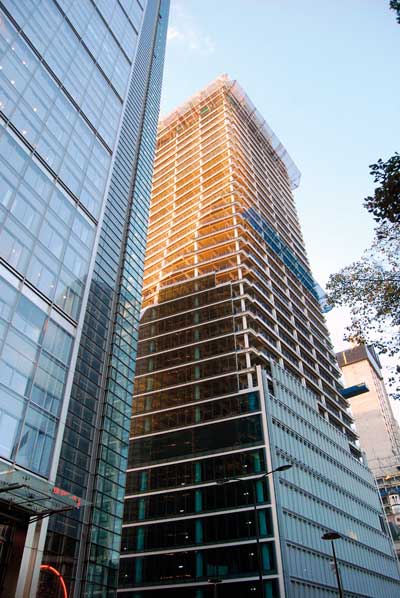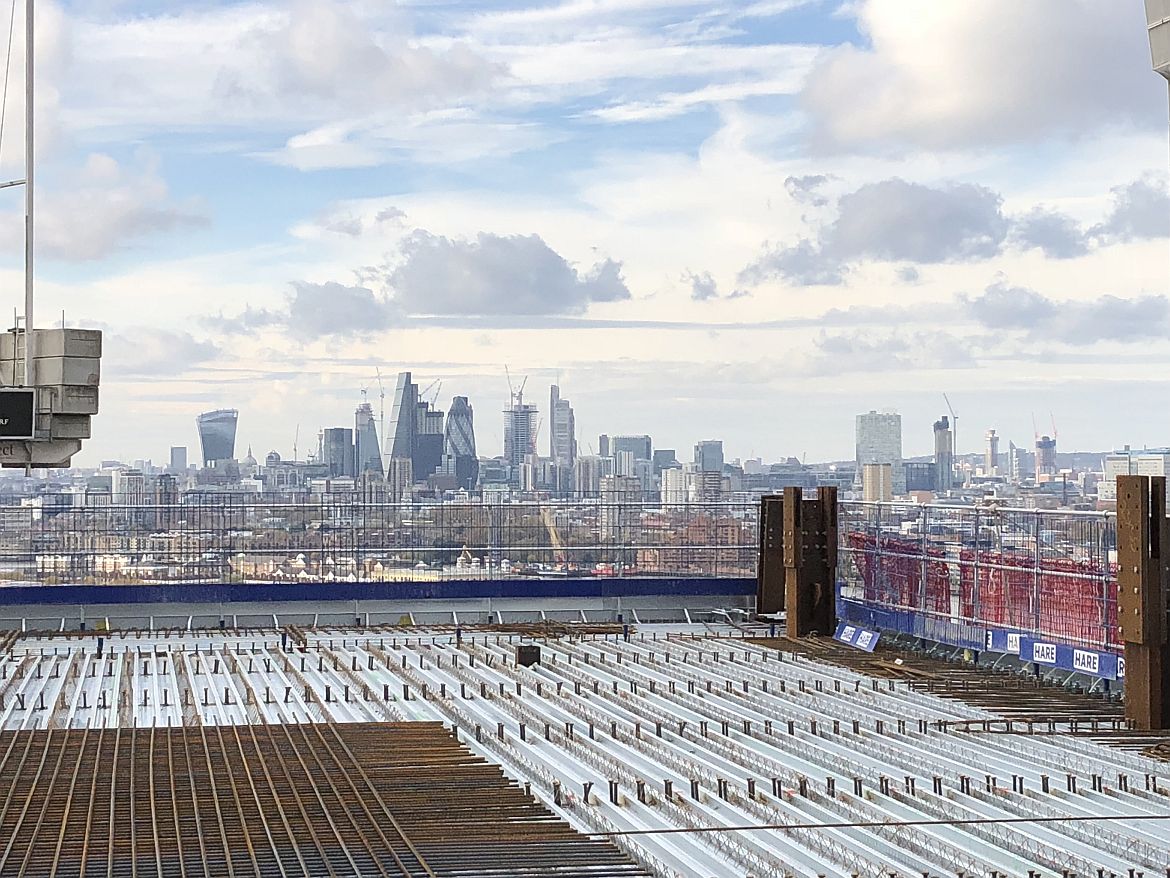PRODECK-FIXING & WILLIAM HARE
STRUCTURAL STEEL IN LONDON’S MOST PRESTIGIOUS NEW BUILDINGS
PRODECK-FIXING & WILLIAM HARE
STRUCTURAL STEEL IN LONDON’S MOST PRESTIGIOUS NEW BUILDINGS
British Steel in London
100 Bishopsgate
Approaching the final stages of the Construction for decking services changing London’s skyline for decking supplied and installed at 100 Bishopsgate.
Canary Wharf
Canary Wharf London …Case Study Coming Soon
Fruit & Wool Exchange
Fruit & Wool Exchange …Case Study Coming Soon
Battersea
Battersea Power Station London…Case Study Coming Soon
Liverpool St
Liverpool St …Case Study Coming Soon
London Wall
London Wall …Case Study Coming Soon

Transforming from a parallelogram at its base to a rectangle at the top, the 40-storey 100 Bishopsgate project is the City of London’s latest stand-out commercial development. Martin Cooper reports.
FACT FILE
100 Bishopsgate, London
Main Client: Brookfield Properties
Architects: Allies and Morrison, Arney Fender Katsalidis
Main contractor: Multiplex Construction Europe
Structural engineer: Robert Bird Group
Steelwork contractor: William Hare
Steel tonnage: 15,000tThe steelwork for 100 Bishopsgate has recently been completed, topping out the frame for the City of London’s latest addition to its ever-changing high-rise cityscape.
This 40-storey mixed-use commercial development, situated a stone’s throw from Liverpool Street Station, will provide just over 83,900m² of net lettable space within its main tower and a contiguous six-storey podium.
The 60m-long podium, adjoining the main tower along its eastern elevation, accommodates large column-free floors in excess of 4,080m². The podium will be topped by a landscaped roof terrace, offering tenants on that floor a large outdoor breakout or entertaining space.
Perimeter steelwork for the scheme starts at ground floor and the frame is sat atop a three-level concrete basement. In addition, there are steel plunge columns temporarily supporting the core extending down within the permanent piles.
Forming this basement was the first part of the construction programme to be undertaken when work kicked off in 2015.
The upper level of the basement was excavated and the ground floor cast. The use of plunge columns then allowed the basement to be constructed top-down simultaneously with the concrete core construction and steel frame erection starting above.
Alongside the development, a new half-acre public realm boasting restaurant and retail amenities will provide pedestrian access between Bishopsgate, St Mary Axe and Camomile Street to the north. Forming another part of the overall scheme, 15-16 St Helen’s Place is separated from the main structure by this realm.

The tower changes shape entirely from level 24

Model showing the main tower and the six-storey podium
The six-storey steel-framed St Helen’s Place structure incorporates a retained façade and shares a basement with 100 Bishopsgate.
The main 40-storey tower provides the main stand-out element of the project. With floorplates ranging from 1,800m² to 2,300m², the space is said to be suitable for a range of City tenants and, unsurprisingly, large parts of the building have already been let. In fact, the scheme is 68% let to various tenants including Royal Bank of Canada, Jefferies, Freshfields and Equinox.
According to architect Allies and Morrison, the form of the tower responds to the geometries of the site and context by transitioning from a parallelogram at its base to a rectangle at its top.
In combination with contrasting façade textures and articulated junctions repeated rotationally around the building, this transition in form lends the tower a distinctive twisting dynamic.
To form this eye-catching shape, two façades, north and south, feature a series of inclined columns. They are installed in a staggered configuration from ground level up to level 24, where the entire building straightens into a rectangle.
The sloping elevations have a fold that stretches upwards from east to west on the north side, with the geometry then reversed on the south façade.
The folds end a bay in from the building’s perimeter at one end, meaning the eastern end of the north elevation slopes and the western end has straight columns. Again, this twisting geometry is reversed on the south side.
In the areas where the folds straighten, raking columns change position, and consequently large axial loads are encountered.
“Large tension and compression forces are transferred to the core in these areas, and in order to help distribute these loads we have two storeys with extra bracing in the floors,” explains Robert Bird Group Director Russell Whitehead.
Based around a centrally-positioned core, steelwork radiates outwards to supporting perimeter columns spaced at 9m centres. Accommodating the building’s services within the structural ceiling void, 700mm-deep Fabsec cellular beams have been used throughout the scheme.
Because of the tower’s changing sloping shape the internal spans along the north and south elevations vary from a maximum of 23m-long to 11m-long on level 24. As the building turns into a rectangle, the levels from floor 24 upwards all have 11m internal spans.
Except for the declining length of the internal beams, the steel frame is fairly repetitive until the uppermost plant level at floors 38 and 39. Here three 4.5m-deep trusses, each 22m-long, have been installed to support plant equipment.
Steelwork contractor William Hare’s package consists of a grand total of 15,000t of steel, which includes more than 6,500 individual pieces. The company, alongside Prodeck-Fixing Ltd, is also installing 90,000m² of ComFlor metal decking for the project’s composite floor construction.
In recognition of its good working practice Multiplex won a Silver Considerate Constructors Scheme 2016 National Site Award. In addition the Project was awarded the City of London Corporation’s Chairman’s Cup for most Considerate Contractor in the City of London. The 100 Bishopsgate job was said to have shown the highest levels of consideration towards the public, its workforce and the environment through adhering to the Scheme’s five-point Code of Considerate Practice.
100 Bishopsgate was complete in 2019.


